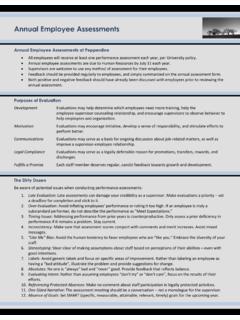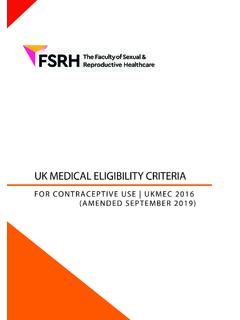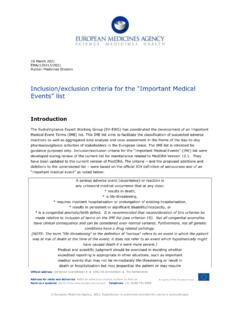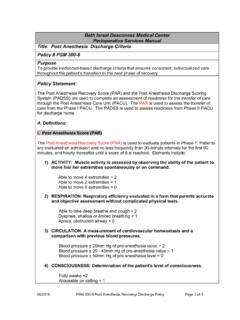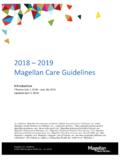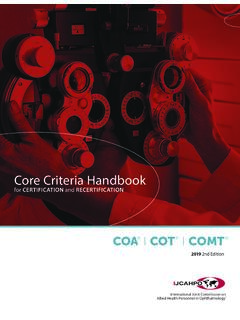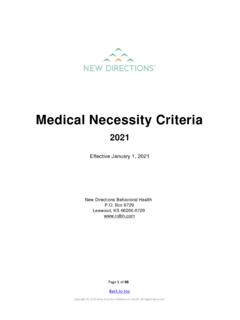Transcription of Establishing Inclusion and Exclusion Criteria
1 Pepperdine University Graduate & Professional Schools Institutional Review Board (GPS IRB) Establishing Inclusion and Exclusion Criteria Establishing Inclusion AND Exclusion Criteria Investigators must include in their protocols a thorough description of the study population. The first priority is that the subject population have the attributes that will make it possible to accomplish the purpose of the research. Establishing Inclusion and Exclusion Criteria for study participants is a standard, required practice when designing high-quality research protocols. Defining Inclusion and Exclusion Criteria increases the likelihood of producing reliable and reproducible results, minimizes the likelihood of harm to the subjects, and guards against exploitation of vulnerable persons. Definitions Inclusion Criteria are characteristics that the prospective subjects must have if they are to be included in the study, or the key features of the target population that the investigators will use to answer their research question.
2 Typical Inclusion Criteria include demographic, clinical, and geographic characteristics such as age, gender, race, ethnicity, marital status, educational experience, language, type of occupation, physical activity, medical conditions, and the presence of medical , psychosocial, or emotional conditions. In contrast, Exclusion Criteria are defined as features of the potential study participants who meet the Inclusion Criteria but present with additional characteristics that could interfere with the success of the study or increase their risk for an unfavorable outcome. Common Exclusion Criteria include characteristics of eligible individuals that make them highly likely to be lost to follow-up, miss scheduled appointments to collect data, provide inaccurate data, have comorbidities that could bias the results of the study, or increase their risk for adverse events such as side effects (most relevant in studies testing interventions), Common errors Common errors regarding Inclusion and Exclusion Criteria include the following: - using the same variable to define both Inclusion and Exclusion Criteria (for example, in a study including only men, listing being a female as an Exclusion criterion); - selecting variables as Inclusion Criteria that are not related to answering the research question; - not describing key variables in the Inclusion Criteria that are needed to make a statement about the external validity of the study results.
3 Furthermore, the investigator must be prepared to provide a rationale in case one or more of the Inclusion or Exclusion Criteria is questioned. The investigator should review the Inclusion and Exclusion Criteria and decide if any group(s) is inappropriately excluded. If the justification for Pepperdine University Graduate & Professional Schools Institutional Review Board (GPS IRB) Establishing Inclusion and Exclusion Criteria the Exclusion of this group is not reasonable with regard to the risks, benefits, and purpose of the research, then this group should be included. Examples An example of Inclusion Criteria for a study of students actively enrolled in their first year of college at a 4-year University and how they are managing the transition from living at home to living in dormitories might be students who are registered as freshman status over the age of 16, currently taking courses at their University, and residing in a University dormitory.
4 An Exclusion criterion for this study might be individuals who meet the Inclusion Criteria but are in their 2nd or 3rd year of taking courses but still registered as freshman due to having a lesser course load (and therefore, the would not be enrolled as a first year ). An example of Inclusion Criteria for a study of patients diagnosed with Major Depressive Disorder and how they respond to Dialectical Behavior Therapy might be all individuals over the age of 18 who have received a diagnosis of this condition from a treatment provider (rather than being self-diagnosed) who are currently receiving Dialectical Behavior Therapy. Exclusion Criteria might be individuals who meet the Inclusion Criteria who have already received Dialectical Behavior Therapy in the past, so that this is not their first exposure to this treatment, or individuals who have only received 5 or less sessions of Cognitive Behavioral Therapy (because this is not enough treatment exposure to measure a response, or individuals who have other diagnosed psychological conditions in addition to Major Depressive Disorder.)
5 An example of Inclusion Criteria for a study of employees at a large corporation and how they are adapting to using videoconferencing technology over 4 weeks might be all individuals over the age of 18 who are currently employed at a corporation with at least 100 employees and who use videoconferencing as part of routine job duties. An Exclusion criterion might be individuals who meet the Inclusion Criteria but do not have the time or interest to log their reactions to videoconferencing technology on a weekly basis for four weeks (the duration of the study). An example of Inclusion Criteria for a study of obese children and daily food intake might be all youth under the age of 18 who meet the medical definition for obesity using BMI. Exclusion Criteria might be the existence of other medical conditions or children whose parents do not express confidence in their ability to log their child s food intake for 2 weeks on a daily basis when questioned by the researcher on screening.
6 An example of Inclusion Criteria for a study of lifestyle-based interventions for counteracting symptoms of menopause might be women between the ages of 45 and 75 who have been diagnosed with menopause. An Exclusion criterion for this study might be individuals who meet the Inclusion Criteria but have abnormal blood tests that might signal the need for medication-based treatment.


